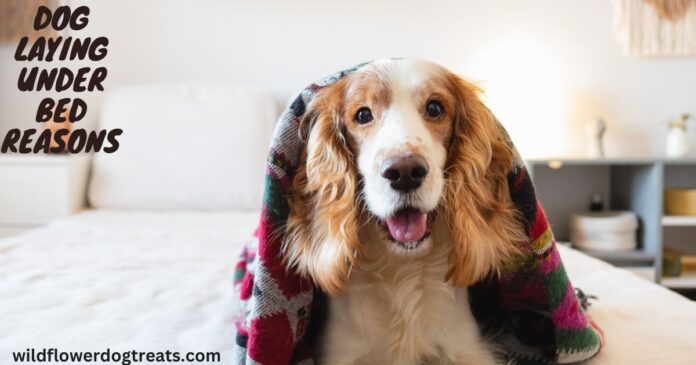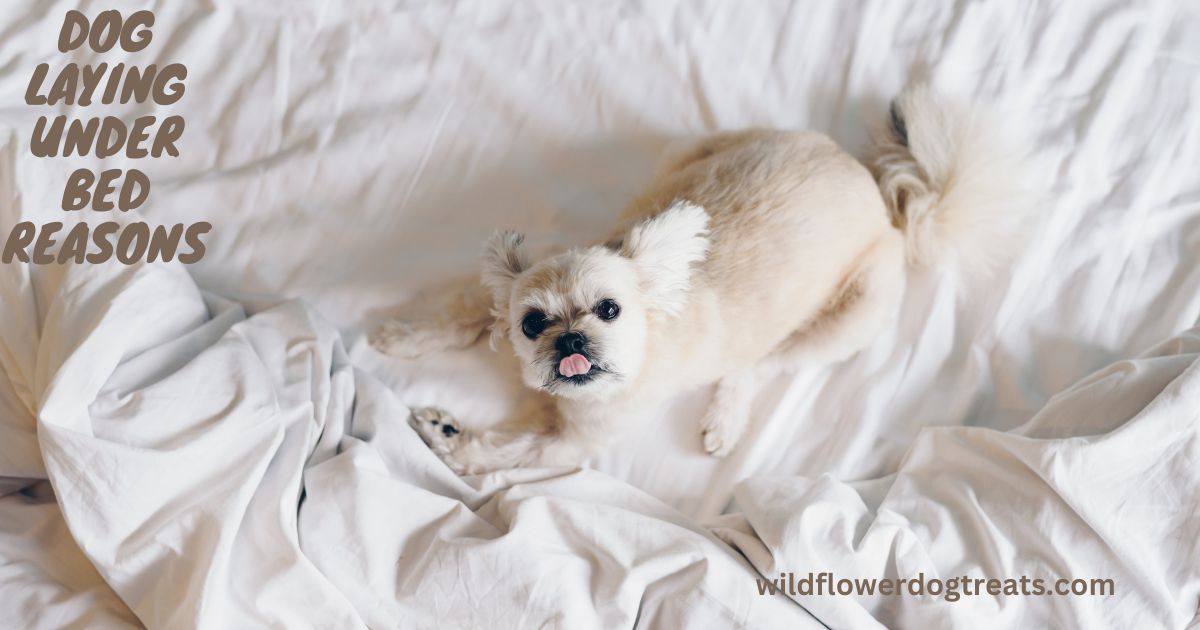Dogs like to lay under the bed for comfort and security. It provides them with a safe and enclosed space that mimics a den, allowing them to feel protected and relaxed. dog laying under bed reasons.
This behavior is instinctual and stems from a dog’s natural desire for a secure and cozy resting place. Laying under the bed also gives them a vantage point to observe their surroundings while feeling hidden, giving them a sense of control and safety.
Additionally, dogs might seek cooler areas to escape heat, and the space under the bed may offer a reprieve from warmer temperatures in the room. Understanding why your dog prefers this location can help you cater to their needs and ensure they feel content and secure in their environment.
Understanding Canine Denning Instinct
Have you ever wondered why your dog prefers to lay under the bed, or any other confined space, despite having a comfortable bed or blanket to rest on? Canine denning instinct, derived from their wild ancestors, plays a significant role in this behavior. Understanding this innate behavior is crucial in providing the best care and environment for your furry friend.
The Evolutionary Explainer
Canines instinctively seek out den-like environments for their safety and protection. This behavior dates back to their wild ancestry when wolves and wild dogs sought refuge in dens to escape harsh weather, predators, and to raise their young. The urge to seek out confined spaces, such as under the bed, is deeply ingrained in their genetic makeup.
The Importance Of Denning Behavior
Denning behavior fulfills your dog’s natural need for security and comfort. By understanding and respecting this instinct, you can provide a secure and calming environment for your furry companion, reducing stress and anxiety levels. It also contributes to their overall well-being and mental health, making them feel safe and protected in their chosen denning space.
Unique Denning Preferences Among Breeds
Different dog breeds may exhibit varying denning preferences based on their ancestral traits. For example, breeds originally used for hunting or burrowing, such as terriers, may show a preference for tightly enclosed spaces, while larger breeds may seek out open and airy spots for denning. Understanding these breed-specific behaviors can help you tailor their environment to best suit their individual needs.
Exploring The Appeal Of Under-bed Laying
Sensory And Safety Factors
One reason why your dog may be drawn to laying under the bed is due to sensory and safety factors. Dogs have a natural instinct to seek out secure, enclosed spaces, which can help them feel protected and secure. The space under the bed provides a cozy, enclosed environment where they can feel safe from potential threats and dangers, providing them with a sense of security.
Temperature And Comfort Considerations
Another factor that may contribute to your dog’s preference for laying under the bed is the temperature and comfort considerations. The space under the bed often offers a cool and shaded area, which can be particularly appealing to dogs, especially during hot weather. This hidden sanctuary can provide a peaceful retreat for your dog to relax and unwind, offering them relief from the heat and a comfortable resting spot away from the hustle and bustle of the household.
Psychological And Emotional Motivations
Furthermore, the psychological and emotional motivations behind your dog’s under-bed preference cannot be overlooked. Dogs are known for their strong denning instincts, and the space under the bed closely mimics the natural den-like environments that canines seek for relaxation and reprieve. This behavior is often rooted in their primal need for a sense of ownership and territory, which can provide them with a feeling of control and autonomy.
Addressing Behavioral Issues
When a dog chooses to lay under the bed, it could be an indication of underlying behavioral issues that need to be addressed. Understanding the potential reasons behind this behavior is crucial for ensuring the well-being of your beloved pet. Addressing these concerns can help create a positive and comfortable environment for your dog, promoting overall happiness and contentment.
Signs Of Anxiety And Fear
Dogs that seek refuge under the bed may exhibit signs of anxiety and fear, such as trembling, excessive drooling, or pacing. Additionally, avoiding eye contact, cowering, or tucking the tail between the legs might signify discomfort and unease. Recognizing these signs is essential in identifying when your dog may be experiencing emotional distress.
Dealing With Separation Anxiety
Separation anxiety is a common issue that often leads dogs to seek shelter in confined spaces like under the bed. To address this concern, it’s important to gradually acclimate your dog to being alone by practicing short departures and providing comforting items, such as a favorite toy or blanket. Implementing a consistent routine and setting up a safe, designated space can aid in alleviating separation-related stress.
Training Techniques For Undesirable Behavior
Implementing effective training techniques can help curb undesirable behaviors, including seeking refuge under the bed. Positive reinforcement through praise and rewards for staying in designated areas can encourage your dog to modify their behavior. Redirecting attention with interactive toys or engaging activities can also discourage the habit of hiding under the bed.
Creating The Perfect Den Area
Many dog owners have noticed their furry companions showing a preference for laying under the bed. This behavior often stems from their natural instincts to seek a secure and comfortable den-like space. Understanding your dog’s instinctual desire for this den-like area can help you create a safe and welcoming space for them to retreat to. Here’s how to design a dog-friendly den, encourage healthy denning habits, and address potential risks and hazards.
Designing A Dog-friendly Den
When creating a den area for your dog, it’s essential to consider their comfort and safety. Start by selecting a cozy and well-ventilated space in your home that’s easily accessible for your dog. Use a soft and cushioned bed or blanket to provide a comfortable resting area. Additionally, consider incorporating familiar scents, such as their favorite toys or items, to make the den area more comforting for your pet.
Encouraging Healthy Denning Habits
Encouraging healthy denning habits in your dog involves positive reinforcement and gradual acclimatization to the den area. Utilize treats and praise to reward your dog for spending time in their designated den space. Avoid forcing them into the area, as this could create negative associations. Instead, make the den area appealing by incorporating elements that align with their natural denning instincts.
Dealing With Potential Risks And Hazards
While creating a den area for your dog, it’s important to be mindful of potential risks and hazards. Ensure that the space is free from any small items or potential choking hazards. Keep electrical cords and toxic substances out of reach to prevent accidental ingestion. Regularly inspect the den area for any signs of wear and tear in bedding or furniture and promptly address any hazards to maintain a safe environment for your pet.
Enhancing The Human-dog Bond
Building Trust And Security
When a dog chooses to lay under the bed, it is often seeking a safe and secure space where it can feel protected and comfortable. Dogs have an instinctual need for a den-like environment, which makes the space under the bed an appealing spot for them. By allowing your dog to find solace in this space, you are helping to build a sense of trust and security within the home. This creates an environment where your dog feels protected and at ease, ultimately strengthening the bond between you and your furry friend.
Strengthening The Dog-owner Relationship
By acknowledging and respecting your dog’s preference to lay under the bed, you are demonstrating an understanding and consideration for your pet’s individual needs. This acknowledgment fosters a stronger bond between you and your dog, as it shows that you are attuned to your pet’s behaviors and desires. Moreover, it offers an opportunity for you to build a deeper emotional connection and understanding with your dog, ultimately strengthening the dog-owner relationship.
Providing Comfort And Affection
Seeking refuge under the bed can often be a sign that your dog craves comfort and affection. By creating an environment where your dog feels comfortable, secure, and loved, you are enhancing the emotional bond between you and your pet. The space under the bed becomes a symbol of warmth and safety, and by allowing your dog to take solace in this area, you are providing the love and care that is essential for a thriving human-dog relationship.
Frequently Asked Questions Of Why Does My Dog Like To Lay Under The Bed
Why Does My Dog Like To Lay Under The Bed?
Dogs like to lay under the bed as it provides them a sense of security and a cozy den-like space. It’s instinctual for them to seek out enclosed spaces for comfort, warmth, and safety. dog laying under bed reasons. Additionally, being under the bed allows them to observe their surroundings while feeling protected.
Is It Normal For Dogs To Prefer Laying Under The Bed?
Yes, it’s absolutely normal. Many dogs find the space under the bed to be comforting and relaxing. dog laying under bed reasons. It’s a natural behavior for dogs to seek out small, enclosed spaces, as it mimics the feeling of being in a den, offering them a sense of security and refuge.
How Can I Encourage My Dog To Lay Elsewhere?
Encourage your dog to lay elsewhere by offering a cozy alternative space, like a dog bed or crate. Add favorite toys or blankets to make the designated area more appealing. dog laying under bed reasons. Positive reinforcement through treats or praise can also help redirect their preference.
Conclusion
Your dog may lay under the bed due to natural instincts, comfort, or a need for security. Understanding their behavior and offering a safe, cozy alternative space strengthens the bond between you and your furry friend.
Discovering the reasons behind your dog’s chosen spot can lead to a happier and healthier relationship for both of you.




